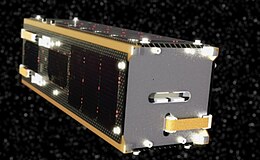The Kosmos-3M was a Russian space launch vehicle, member of the Kosmos rocket family. It was a liquid-fueled two-stage launch vehicle, first launched in 1967 and with over 420 successful launches to its name. The Kosmos-3M used UDMH fuel and AK27I oxidizer to lift roughly 1,400 kg (3,100 lb) of payload into orbit. It differed from the earlier Kosmos-3 in its finer control of the second-stage burn, allowing operators to tune the thrust and even channel it through nozzles that helped orient the rocket for the launching of multiple satellites at one time. PO Polyot manufactured these launch vehicles in the Russian city of Omsk for decades. It was originally scheduled to be retired from service in 2011; however, in April 2010 the Commander of the Russian Space Forces confirmed that it would be retired by the end of 2010. One further launch, with Kanopus-ST, was planned; however, this was cancelled in late 2012 as the launch vehicle had exceeded its design life while in storage ahead of the launch.
Surrey Satellite Technology Ltd, or SSTL, is a company involved in the manufacture and operation of small satellites. A spin-off company of the University of Surrey, it is presently wholly owned by Airbus Defence and Space.
CLEO - Cisco router in Low Earth Orbit, is an Internet router from Cisco Systems that was integrated into the UK-DMC Disaster Monitoring Constellation satellite built by Surrey Satellite Technology Ltd (SSTL) as a secondary experimental hosted payload, and launched into space with the satellite from Plesetsk on 27 September 2003.

The National Space Research and Development Agency (NASRDA) is the national space agency of Nigeria. It is a parastatal under Federal Ministry of Science and Technology. The agency is based in the Nigerian capital city of Abuja in the Lugbe district and has a ground receiving station, among various other sites. It has had cooperation in space technology with the United Kingdom, China, Ukraine and Russia. The agency has struggled with meeting its financial plans and some of its facilities are rundown. Despite this, the space agency is one of the most advanced space agencies in Africa, boasting of four satellites and very grand ambitions. Nigeria's satellites have been praised for their high-resolution images.
The Disaster Monitoring Constellation for International Imaging (DMCii) or just Disaster Monitoring Constellation (DMC) consists of a number of remote sensing satellites constructed by Surrey Satellite Technology Ltd (SSTL) and operated for the Algerian, Nigerian, Turkish, British and Chinese governments by DMC International Imaging. The DMC provides emergency Earth imaging for disaster relief under the International Charter for Space and Major Disasters, which the DMC formally joined in November 2005. Other DMC Earth imagery is used for a variety of civil applications by a variety of governments. Spare available imaging capacity is sold under contract.
UoSAT-12 is a British satellite in Low Earth Orbit. It is the twelfth satellite in the University of Surrey series and was designed and built by Surrey Satellite Technology Ltd. (SSTL). It was launched into orbit in April 1999 on board a Dnepr rocket from Yasny Russia.
DMC International Imaging (DMCii) is the company that manages the Disaster Monitoring Constellation for the International Charter for Space and Major Disasters. It also sells satellite imaging services under contract and manages the operations of spacecraft such as UK-DMC1 & UK-DMC2. DMCII is a wholly owned subsidiary of Surrey Satellite Technology Ltd (SSTL). It recently struck a space deal with Beijing-based 21AT to build three high-resolution earth observation satellites to map the growth of China.
SNAP-1 is a British nanosatellite in low Earth orbit. The satellite was built at the Surrey Space Centre by Surrey Satellite Technology Ltd (SSTL) and members of the University of Surrey. It was launched on 28 June 2000 on board a Kosmos-3M rocket from the Plesetsk Cosmodrome in northern Russia. It shared the launch with a Russian Nadezhda search and relay spacecraft and the Chinese Tsinghua-1 microsatellite.
Deimos-1 is a Spanish Earth imaging satellite which is operated by Deimos Imaging who commercializes its imagery directly but also has distribution agreements with other entities like Astrium GEO and DMC International Imaging.
UK-DMC 2 is a British Earth imaging satellite which is operated by DMC International Imaging. It was constructed by Surrey Satellite Technology, based on the SSTL-100 satellite bus. It is part of Britain's contribution to the Disaster Monitoring Constellation, which is coordinated by DMC International Imaging. It is the successor to the UK-DMC satellite.
UK-DMC or UK-DMC 1, also known as BNSCSAT-1, was a British satellite that formed part of the Disaster Monitoring Constellation (DMC). It was built by Surrey Satellite Technology, who operated it via DMC International Imaging on behalf of the British National Space Centre and later the UK Space Agency. It was launched alongside other DMC satellites on 27 September 2003, and retired from service in November 2011.

The Algerian Space Agency, was established on January 16, 2002 in Bouzareah, Algiers. The agency is in charge of the Algerian space program, and has flown five different satellites.
STRaND-1 is a failed 3U CubeSat developed by Surrey University's Surrey Space Centre (SSC) and Surrey Satellite Technology (SSTL). The 4.3 kg (9.5 lb) nanosatellite was launched into orbit on board a PSLV Rocket from India on February 25, 2013, Smartphones have flown in space before inside the International Space Station, and the computer from a PDA launched inside two Japanese CubeSats in 2006 and 2008.
BILSAT-1 was an earth observation satellite designed and developed by TÜBİTAK Space Technologies Research Institute and produced in Turkey as part of the Disaster Monitoring Constellation (DMC) project in the context of a show-how program led by DMC International Imaging of Surrey Satellite Technology (SSTL).

Sir Martin Nicholas Sweeting is the founder and executive chairman of Surrey Satellite Technology Ltd (SSTL). SSTL is a corporate spin-off from the University of Surrey, where Sweeting is a Distinguished Professor who founded and chairs the Surrey Space Centre.
UK-DMC 3 is a constellation of three British Earth imaging satellites which are operated by DMC International Imaging. They were constructed by Surrey Satellite Technology and launched by ISRO on 10 July 2015.
Alsat-1B is an Algerian satellite operated by the Agence Spatiale Algerienne for agricultural and disaster monitoring. The contract for the mission was signed in July 2014. The satellite is based on the SSTL-100 bus. The satellite weighs 103 kilograms (227 lb) and carries an earth imaging payload with 12-metre (39 ft) panchromatic imager and 24-metre (79 ft) multispectral cameras.
The National Space Program (PSN) horizons 2020 planned to put in place space infrastructures, space systems and increase the specialized human resources in space technologies. Among the space systems planned in the PSN are Algeria's satellites, of which a significant number should be partly or totally integrated in the Algerian center for satellite development "CDS". CDS offers the technological environment for national competence to develop the future Algerian satellite systems. Algeria's objectives is to make of space tools a powerful instrument in national prosperity in the fields of earth observation, meteorology and communications.

PSLV-C42 was the 44th mission of the Indian Polar Satellite Launch Vehicle (PSLV) program and its 12th mission in the Core Alone (CA) configuration. PSLV-C42 successfully carried and deployed 2 earth observation satellites in sun-synchronous orbits at an altitude of 588 kilometres (365 mi). It was launched on 16 September 2018 by the Indian Space Research Organisation (ISRO) from the first launch pad of the Satish Dhawan Space Centre at Sriharikota, Andhra Pradesh. The two international satellites were launched as part of a commercial arrangement between Surrey Satellite Technology Limited (SSTL) and ISRO's commercial arm Antrix Corporation Limited, run under the auspices of the Indian Government's Department of Space.

RSat-P is a microsatellite built by the United States Naval Academy (USNA) in Annapolis, Maryland. The small spacecraft is a 3U CubeSat intended to demonstrate capabilities for minor in-orbit repair of a much larger, conventional spacecraft.





